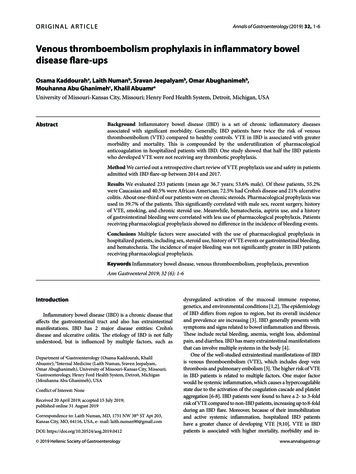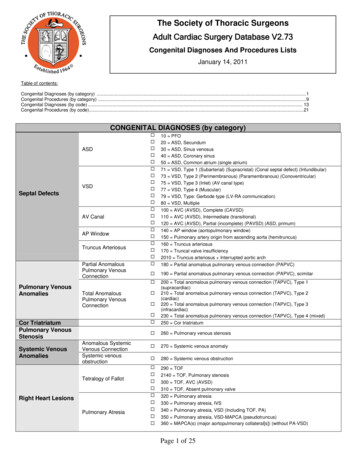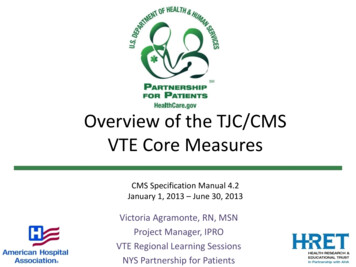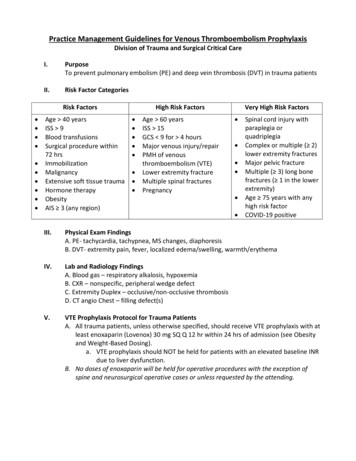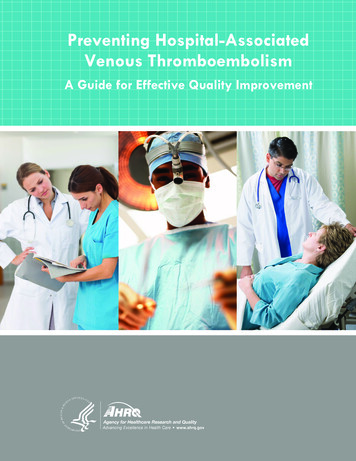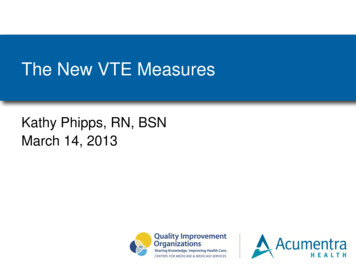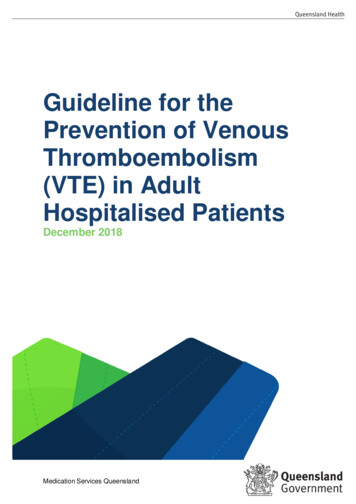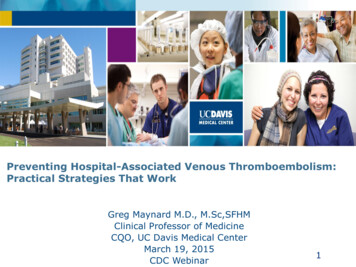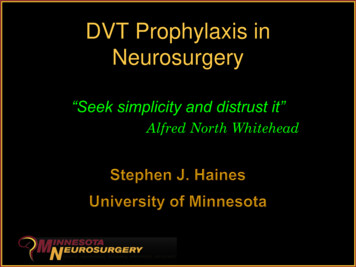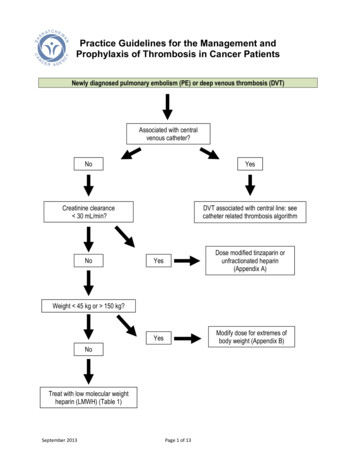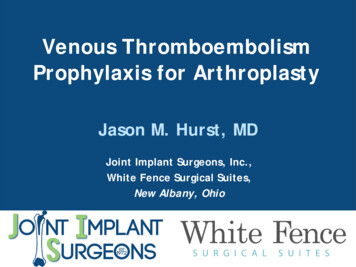
Transcription
Venous ThromboembolismProphylaxis for ArthroplastyJason M. Hurst, MDJoint Implant Surgeons, Inc.,White Fence Surgical Suites,New Albany, Ohio
Jason M. Hurst, MD DisclosureConsultant: Zimmer Biomet TJOResearch Support: Zimmer Biomet; Pacira Pharmaceuticals;Orthosensor; SPR Therapeutics
Incidence of SymptomaticPE with No ProphylaxisTHA:TKA:20%8%Comp et al., JBJS 2001
Incidence of Fatal PE followingTHA or TKA Regardless ofChemoprophylactic Agent0.1% - 0.2%Brookenthal et al., J Arth 2001Freedman et al., JBJS 2000Larson et al., JSOA 2001Nassif et al., J Arth 2000Sarmiento & Goswami, JBJS 1999Lieberman et al., JBJS 1997
What does it look like?
DVT: Exam, ImagingPain, swelling, erythemaHoman’s unreliable,nonspecificVenography gold standardVenous duplex U/S 96% sensitive, 98% specificAlternatives: CT,plethysmography
PE: ExamAcute pleuritic painDyspneaHypoxiaTachypneaTachycardiaEKG, ABG, vitals,pulse oxCXRPulmonary angiogram gold standardHelical chest CT First lineNuclear med - V/Qscan
It is IMPERATIVE to try andprevent this post-operativecomplication
What’s the protocol?
Chest 2012; 141(2 Suppl)Y Falck-Ytter; CW Francis; NA Johanson; C Curley; OEDahl; S Schulman; TL Ortel; SG Pauker; CW Colwell JrACCP Guidelines on Prevention of VenousThromboembolism in Orthopedic Surgery Patients, 9th ed.
ACCP Guidelines on Prevention of VTE inOrthopedic Surgery Patients, 9th ed.2.1.1 & 2.1.2. For THA or TKA recommend one offollowing rather than no prophylaxis for minimum of 1014 days (all Grade 1B): Low molecular weight heparin (LMWH) Fondaparinux, Dabigatran, or Apixaban Rivaroxiban (THA or TKA but not hip fracture) Low-dose unfractionated heparin (LDUH) Adjusted-dose vitamin K antagonist (AD VKA) Aspirin Or (Grade 1C) intermittent pneumatic compressiondevice (IPCD)Falck-Yetter et al., CHEST 2012
ACCP Guidelines on Prevention of VTE inOrthopedic Surgery Patients, 9th ed.2.2. For THA/TKA and receiving LMWH, we recommendstarting either 12 h preop or 12 h postop rather thanwithin 4 h preop or 4 h postop (Grade 1B)2.3.1 & 2.3.2. For THA/TKA, irrespective of concomitantuse of ICPD or length of treatment, suggest use of LMWHin preference to other recommended alternative agents:ARIXTRA, ELIQUIS, PRADAXA, XARELTO (not HFS), LDUH(all Grade 2B), AD VKA, or aspirin (all Grade 2C)2.4. Suggest extending prophylaxis in outpatient periodfor up to 35 days rather than only 10-14 days (Grade 2B)2.5. Suggest using dual prophylaxis with antithromboticagent and IPCD during hospital stay (Grade 2C)Falck-Yetter et al., CHEST 2012
ACCP Guidelines on Prevention of VTE inOrthopedic Surgery Patients, 9th ed.2.6. In patients with major bleeding risk, suggest usingIPCD or no prophylaxis rather than pharmacologictreatment (Grade 2C)2.7. In patients who decline or are uncooperative withinjections or/and IPCD, recommend apixaban ordabigatran (if unavailable then alternatively rivaroxabanor AD VKA) rather than alternate forms of prophylaxis(all Grade 1B)2.8. Suggest against using IVC filter for primaryprevention over no prevention in patients with increasedbleeding risk or contraindications to both pharmacologicand mechanical thromboprophylaxisFalck-Yetter et al., CHEST 2012
ACCP Guidelines on Prevention of VTE inOrthopedic Surgery Patients, 9th ed.2.9. For asymptomatic patients we recommendagainst Doppler or duplex ultrasound (DUS)screening before hospital discharge (Grade 1B)3.0 Suggest no prophylaxis rather thanpharmacologic thromboprophylaxis in patient withisolated lower-leg injuries requiring immobilization(Grade 2C)4.0. For patients undergoing knee arthroscopywithout a history of prior VTE, suggest nothromboprophylaxis rather than prophylaxis (Grade2B)Falck-Yetter et al., CHEST 2012
ACCP Guidelines for Duration of Prophylaxis Basic Summary for TKA and THA:Prophylaxis for minimum 10-14 days (all Grade 1B) : Low molecular weight heparin (LMWH) Fondaparinux Dabigatran, Apixaban, Rivaroxiban Low-dose unfractionated heparin (LDUH) Adjusted-dose vitamin K antagonist (AD VKA) Aspirin (Grade 1B) Intermittent pneumatic compression device (IPCD)(Grade 1C)
Clinical Guideline on Prevention ofSymptomatic Pulmonary Embolism inPatients Undergoing THA or TKADisclaimer: educational tool notintended to be a fixed protocol clinician’s independent medical judgmentNo mention of UKA
Prevention of Venous Thromboembolismfor THA & TKAStandard risk PE; Standard risk bleeding ASA, LMWH, Pentasaccharides, WarfarinElevated risk of PE; Standard risk bleeding LMWH, Pentasaccharides, WarfarinStandard risk of PE; Elevated risk bleeding Aspirin, Warfarin, NoneElevated Risk PE; Elevated risk bleeding Aspirin, Warfarin, None
AAOS Recommendations, THA & TKAAssess risk: PE & major bleedingKnown contraindications to anticoagulation:consider vena cava filterIntraoperative and IPO mechanical prophylaxisWith anesthesiologist, consider regionalPostop, continue mechanical prophylaxis untildischarge to homeMobilize as soon as feasibleRoutine postop screening in asymptomatic patientsis not recommendedEncourage progressively mobility after dischargeEducate patient re: common symptoms of VTE
SCIPHospital inpatient quality process measures For total joint surgery, recommend the use ofLMWH, fondaparinux, or warfarin For hip factures, allow above plus LDUHDo not address dosages or appropriate INR level forpatients treated with warfarinRecommend mechanical prophylaxis only for hippatients at high bleeding riskKnee patients whose surgeries lasted 60 minutes orwhose hospital stays were 3 days are excluded fromSCIP-VTE-1 and 2Haralson, AAOS Now
Surgical Care Improvement Project(SCIP) GuidelinesRecommend for THA and TKA: LMWH Fondaparinux WarfarinPneumatic compression deviceswith or without aspirin for TKA only
Complications of VTEGuidelines?
10 Days of LMWH after TJA4.7% Readmission rate3.4% I&D rate5.1% Prolonged hospitalizationBurnett et al., J Arth 2007
Does “Excessive” AnticoagulationPredispose to Periprosthetic Infection?2-to-1 case control study Study Group: 78 Septic failures Control: Same index proceduresHematoma and wound drainage weresignificant risk factors for infectionINR greater than 1.5 was a risk forinfectionParvizi et al., J Arthroplasty 2007
Partial Knees andTotal Knees areDifferent
The Incidence and Prevention ofSymptomatic VTD following UKA432 UKA in 362 Patients 8 lateral fixed bearing 424 medial UKA 34 inlay fixed bearing 49 fixed bearing 341 mobile bearingLombardi et al., Orthopedics 2007
Multimodal VTD ProphylaxisWithout significant risk factors ECASA 325 BID x 6 weeks 83% of UKAWith significant risk factors Warfarin resumed 1.6% LMWH for 2 weeks; ECASA 4 weeks 8.1% LMWH Bridge; Warfarin 6 weeks 6.4%Lombardi et al., Orthopedics 2007
Review of 1000 Consecutive UKA1000 consecutive UKA (828 patients) Rapid recovery protocol Multimodal VTE prophylaxisResults: 5 (0.5%) transfusion for postop anemia 1 (0.01%) symptomatic DVT within 90days No symptomatic PE Average hospital LOS: 1.4 daysBerend et al., Orthopedics 2010
Take Home MessageACCP, AAOS, & SCIP Guidelines varyAAOS Guidelines support riskstratification based on bleeding vs. PESCIP Guidelines approve of pneumaticcompression devices with or withoutaspirin for TKA With High Bleeding risk!
Take Home MessageBasic Protocol Options High Risk for DVT Chemoproph for 2 weeks SCDs for 2 weeks Moderate Risk for DVT ASA for 6 weeks SCDs for 2 weeks
Take Home MessageUKA has a lower risk of venousthromboembolic disease than TKA
3.0 Suggest no prophylaxis rather than pharmacologic thromboprophylaxis in patient with isolated lower-leg injuries requiring immobilization (Grade 2C) 4.0. For patients undergoing knee arthroscopy without a history of prior VTE, suggest no thromboprophylaxis rather than prophylaxis (Grade 2B) Falck-Yetter et al., CHEST 2012
